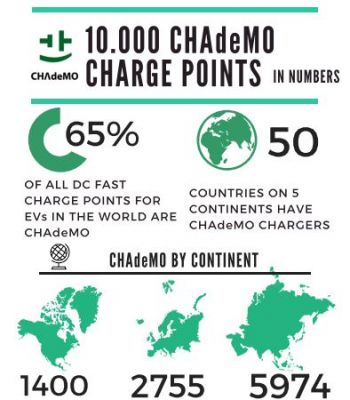HISTORY
- 2010
- 2011
- 2012
- 2013
- 2014
- 2015
- 2016
- 2017
- 2018
In March, Toyota Motor Corporation, Nissan Motor Co. Ltd., Mitsubishi Motors Corporation, Fuji Heavy Industries Ltd., and Tokyo Electric Power Company, Inc. had formally established “CHAdeMO Association.” Mr. Tsunehisa Katsumata, chairman of TEPCO, was inaugurated as the first president of CHAdeMO. At the time 158 business entities and government bodies including 20 foreign companies from multiple sectors such as automakers, electric utility companies, charger and component manufacturers, charging service providers, etc. joined the Association. The Association aimed to support the diffusion of electric vehicles, which would contribute to reduction of CO2 emissions in the transport sector, and to take an active role in the standardisation of EV charging protocols.
In July, the first CHAdeMO Europe meeting was held, in which a decision was made to establish the European steering committee led by PSA, Nissan, Mitsubishi Motors, Think, Endesa, ESB, ABB and the City of Amsterdam.
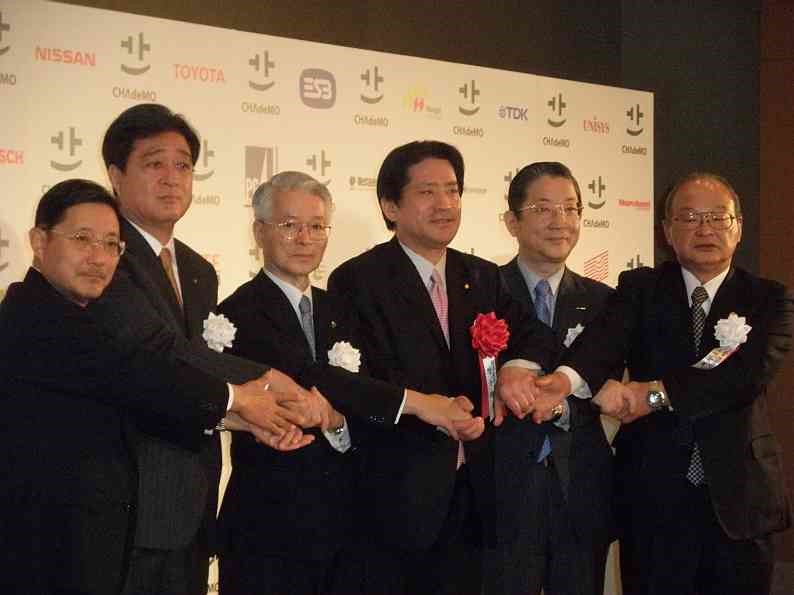
In March, the number of charger manufacturers that developed and offered CHAdeMO DC quick chargers increased from 5 to over 20 world-wide. As a result, the number of installed chargers reached 582 in Japan and 41 in other countries. Major models using the charger were Mitsubishi Motors Corporation’s i-MiEV and Fuji Heavy Industries’ Subaru Plug-in Stella, Nissan Motor Company’s newly-released LEAF, Peugeot iON and Citroen C-ZERO.
After the Great East Japan Earthquake, the need for EV battery as back-up power source during a power failure heightened. With the increasing integration of renewable energy sources in the power mix world-wide, the additional value of EV as enabler for peak shaving and as back-up energy source attracted further attention. In October, the Association started a V2H extension work group to develop bi-directional charging specifications using the CHAdeMO DC charging interface.
As fast charger network expanded, the Association studied the feasibility of the “membership” business model to evaluate how to reduce the initial investment costs in EV charger. Upon completion of the study, in December 2011, several DC fast charging service companies using this model were established.
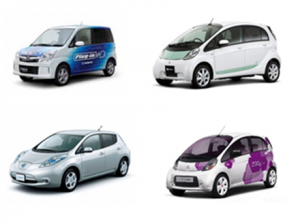
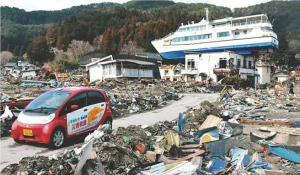
Since the launch of CHAdeMO fast chargers in 2010, they have been steadily growing in numbers and expanding geographically. From March 2010 to March 2012, member companies grew from 158 to 429 with international regular member segment showing the highest growth rate, confirming the global appeal of CHAdeMO protocol.
In January, CHAdeMO protocol ver. 1.0 was published. Also in October, products using the DC discharge function (V2X) based on the CHAdeMO protocol were developed and put into practical use, such as Nissan’s LEAF to HOME and Mitsubishi Motors’ MiEV Power BOX. The Association set up a WG to formulate the common specifications for the system interface in coordination with the relevant parties.
With increased charger installation, the importance of sharing charger information became a common concern to charging infrastructure stakeholders. Amidst this backdrop, CHAdeMO Association has set up its Location Information WG. In March 2013, we started sharing key information on charging stations in the CSV format on the CHAdeMO Association website.
METI launched a large-scale project named “Next Generation Vehicle Charging Infrastructure Deployment Promotion Project,” using 100 billion JPY of supplementary budget for Fiscal Year 2012. With the objective of strategic and quick deployment of charging infrastructure, this project has encouraged municipalities and motorway operating organisations in Japan to issue charger deployment plans, which were made public in April 2013. In addition to the government support, in July 2013, four automakers – Toyota, Nissan, Honda, and Mitsubishi Motors, announced the launch of the “PHV/PHEV/EV Charging Infrastructure Promotion Project.” However, as these projects were quite large-scale, many municipalities were not able to follow through on the concrete installation plan within the initially set time frame. As a result, a one-year extension to the original February 2014 deadline for application for these funds was agreed.
In September, a CHAdeMO-coloured C-ZERO ran 1,000 km over 4 days in the South-West of France, covering around 325 km per day. As a part of the EV rally, Tour Poitou-Charentes, which covered 350 km over 2 days, the CHAdeMO team upped the challenge by driving 650 km 100% electrically, from the start of the rally and back, using the fast chargers available along the way and reporting on the adventure in real-time through social media. The trip demonstrated that driving long distances in an EV that has about 120km of autonomy was possible with CHAdeMO chargers. A number of regional and specialist media outlets wrote about CHAdeMO team’s challenge.
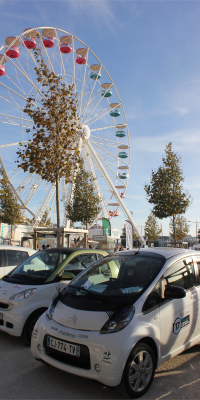
By March, the count for CHAdeMO chargers reached 1,000 in Europe. The European Union has decided to embrace multistandard charging in their final wording of the Alternative Fuels Infrastructure directive. The adoption of multistandard charging followed and confirmed the market trend. The standards related to DC charging were approved by the International Electrotechnical Commission (IEC) and published as IEC61851‐23/24 and IEC62196-3 from March to July in 2014. These standards define the DC charging system, digital communication and connector specifications.
The four vehicle manufacturers – Toyota, Nissan, Honda and Mitsubishi Motors – announced the launch of the “PHV, PHEV and EV Charging Infrastructure Assistance Project”. In May 2014 Nippon Charge Service LLC (NCS) was established, with additional funding from the Development Bank of Japan Inc., Tokyo Electric Power Company, Inc., and Chubu Electric Power Company, Inc. The new company compensated for the installation cost, which was not fully covered by government subsidies, and provided car owners with a universally-accepted charging card, enabling them to use all chargers in the NCS charging station network. The system was expected to accelerate the deployment of charging infrastructure.
The CHAdeMO Team joined the world’s biggest EV rally ‘the WAVE Trophy’. The Team, led by the European Secretariat, traversed Germany, Austria and Switzerland, driving 2,000 km in total over 10 days, 100% electrically. The team was supported in its mission of promoting fast charging by a portable CHAdeMO charger from a Swiss member company EVTEC, which was placed on board a CHAdeMO-compatible Peugeot PARTNER. With an additional mission of providing fast charging top-up to 11 CHAdeMO-compatible EVs participating in the rally along the way, the team clocked in 66 charging sessions in total and helped two teams gain 2nd and 3rd places in the ‘Popular WAVE’ category, showcasing in real-life the benefits of fast charging.
Following the IEC standardisation, JIS D61851-23/24 and JIS D62196-3 were published in Japan in October 2014. In Europe, the IEC standards have been adopted as EN standards (EU) as well as EU member states’ national standards, such as DIN standards (Germany) and BS standards (UK). In North America, DC charging standard 2030.1.1TM-2015 was published by the Institute of Electrical and Electronics Engineers (IEEE), based on the IEC standards, in March 2016.
In September, CHAdeMO technical specification version 1.1 was released. The changes included:
- Dynamic control of maximum charging current, which allows the charger to dynamically change the available output current during charging.
- Requirement for small diameter charging cable to accommodate for low-capacity DC chargers that provide advantages such as user-friendliness.
- Manufacturers’ optional codes, which enable vehicle and charger manufacturers to have their own unique functions using the CHAdeMO interface.
- The emergency stop button will no longer be obligatory. In version 1.1, it will simply be described as something to “follow standards and regulations of the country/region”. However, this will not be applied to 0.9 chargers, i.e. this does not authorise modification of 0.9 chargers regarding the emergency stop button.
In December, CHAdeMO Association and its members celebrated the mark of 10,000 CHAdeMO charge points globally. Result of collaboration among electricity providers, automakers, operators and hardware manufacturers, the achievement was an important milestone in the development of the protocol and a sign of its growing global recognition.
In February, CHAdeMO gained a new level of recognition and was published as IEEE standard 2030.1.1TM-2015. In the same month Nissan and BMW have announced their results of an EV infrastructure deployment project in the United States. As a part of the project, a total of 120 CHAdeMO-Combo1 multi-standard DC fast chargers (50 kW) were installed in 19 states.
Also, CHAdeMO held several booths at the main electromobility events and exhibitions in Europe. Remaining loyal to its goal of promoting electromobility and fast charging, CHAdeMO participated in Hannover Messe in May, EVS29 in July, and eCarTech in October.
In June, development of new high power CHAdeMO was announced. This was the first step towards developing 200kW protocol which came out in 2017.
The number of CHAdeMO stations worldwide reached 17,000 by the end of 2017. In March, the Hannover Declaration between Germany and Japan was signed by the ministries. The declaration paved the way for collaboration between these two countries in various domains including the automotive industry, Industries 4.0 and others. As such, the countries agreed to support cooperation between companies, research institutes and platforms in these fields, discuss recommendations for improving such cooperation, and explore common interests and joint contributions to bilateral / international standardisation for the next generation EV charging system.
The 200 kW protocol (CHAdeMO 1.2) was published and the presentation for 400 kW protocol (2.0) started. The changes included:
- Increasing the current output from 125A to 400A.
- Introducing multi-outlet charger which allows the EV users to charge multiple vehicles simultaneously.
- Enhancement of electrical safety mmeasures.
- Improvement of compatibility by defining stop period of a ground fault detector.
The new protocol was tested during the high power CHAdeMO demonstration event that took place in Ise, Japan, in March. During the event several new technologies and developments were displayed, including high power charging, which is three-times faster than the existing 50 kW charging, new testing device, and V2X technology.
INTIS (Integrated Infrastructure Solutions GmbH) in partnership with CHAdeMO member Technische Hochschule Deggendorf (THD) succeeded in applying CHAdeMO DC fast charging standard to high-powered inductive charging, also known as wireless power transfer (WPT), based on the Transrapid dynamic WPT application.
Also, Nissan and BMW have announced the expansion of their joint initiative for multi-standard fast charging infrastructure. Over 200 additional 50 kW DC fast charging stations were to be installed across 33 states in the US by the end of 2017.
CHAdeMO has crossed the global 20,000 mark for charger installation and reached 1 million of CHAdeMO compatible EVs globally. Also, a number of important changes and updates took place.
In June, new CHAdeMO 2.0 protocol (400 kW) was released, significantly increasing the voltage to 1 kilovolt and thus paving the way towards large commercial vehicles such as trucks and buses. Following the release, CHAdeMO high-power vehicle/charger test event took place in Lucerne, Switzerland. multiple interoperability tests between versions 1.2 and 2.0 were conducted successfully, and over 100 kW charging with current close to 300A was demonstrated.
On 28th August, CHAdeMO Association and the China Electricity Council (CEC), a government approved association in charge of standardisation of EV charging equipment, signed a Memorandum of Understanding. The MoU marks the beginning of collaboration in the technical domain between CEC’s GB/T standard and the CHAdeMO standard with the hope of harmonisation in the international ultra-fast charging standardisation arena in the future.
TIMELINE
Decade long electric journey and planning for high power
To respond to the ever-increasing capacity of EV batteries and to keep the charge time to a minimum, development of the next generation CHAdeMO for higher power is ongoing.






